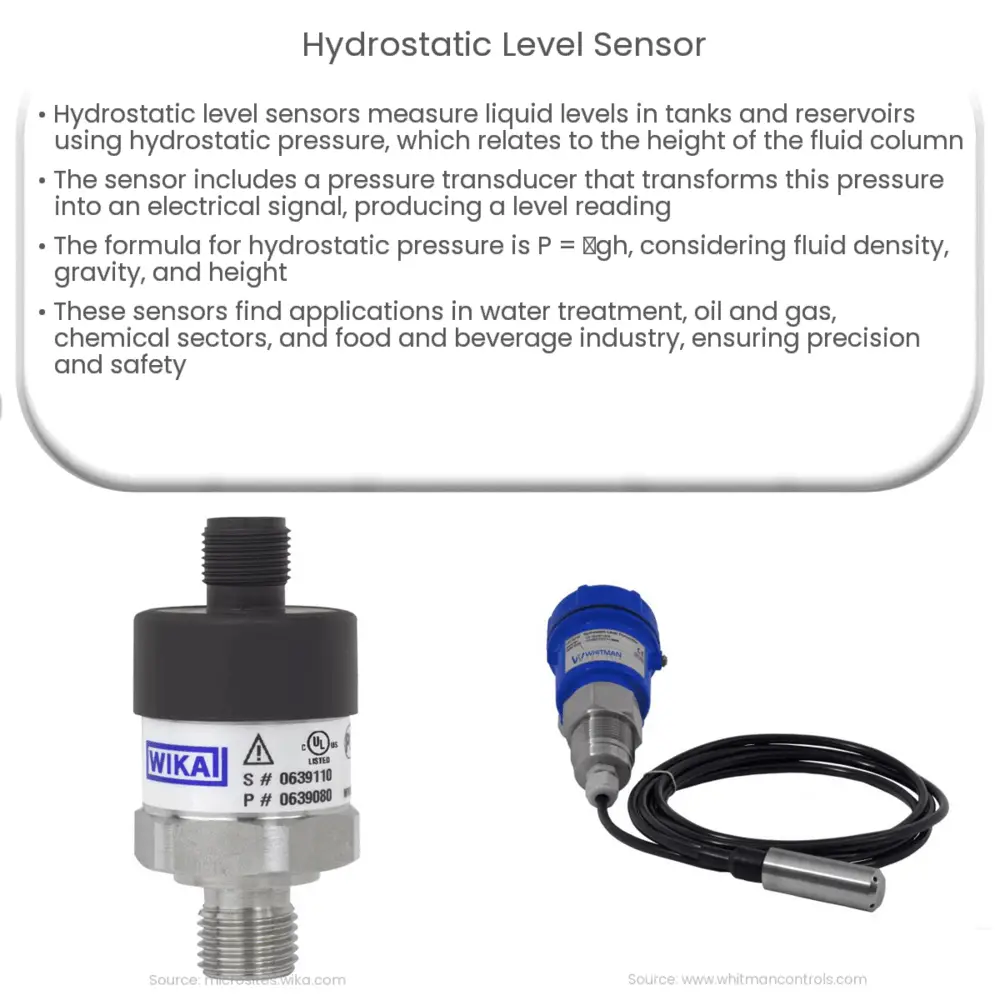Hydrostatic level sensors are a widely used and reliable method for measuring liquid levels in various industries, including water and wastewater treatment, oil and gas, chemical and petrochemical, and food and beverage. They offer several advantages, such as simple and reliable operation, high accuracy, versatility, immunity to external factors, and a wide range of customization options. By selecting the appropriate sensor type, material, and mounting method, users can optimize the performance and durability of their hydrostatic level sensors to meet the specific needs of their applications.

Hydrostatic Level Sensor: Principles, Applications, and Advantages
Introduction
Hydrostatic level sensors are widely used in various industries for the measurement of liquid levels in tanks, reservoirs, and other containers. These sensors operate on the principle of hydrostatic pressure, which is the pressure exerted by a fluid at rest due to the force of gravity. The hydrostatic pressure is directly proportional to the height of the fluid column above the measurement point. In this article, we explore the working principles, applications, and advantages of hydrostatic level sensors.
Working Principle
A hydrostatic level sensor typically consists of a pressure transducer or transmitter that converts the hydrostatic pressure exerted by the fluid column into an electrical signal. This signal is then processed and converted into a level reading. The pressure transducer can be a piezoresistive, capacitive, or strain gauge type, among others. These transducers vary in their sensitivity, accuracy, and response time, making them suitable for different applications.
The hydrostatic pressure at a specific depth in a liquid is calculated using the formula:
P = ρgh
Where P is the hydrostatic pressure, ρ (rho) is the density of the liquid, g is the acceleration due to gravity, and h is the height of the liquid column above the measurement point.
Hydrostatic Level Sensor: Principles, Applications, and Advantages
Introduction
Hydrostatic level sensors are widely used in various industries for the measurement of liquid levels in tanks, reservoirs, and other containers. These sensors operate on the principle of hydrostatic pressure, which is the pressure exerted by a fluid at rest due to the force of gravity. The hydrostatic pressure is directly proportional to the height of the fluid column above the measurement point. In this article, we explore the working principles, applications, and advantages of hydrostatic level sensors.
Working Principle
A hydrostatic level sensor typically consists of a pressure transducer or transmitter that converts the hydrostatic pressure exerted by the fluid column into an electrical signal. This signal is then processed and converted into a level reading. The pressure transducer can be a piezoresistive, capacitive, or strain gauge type, among others. These transducers vary in their sensitivity, accuracy, and response time, making them suitable for different applications.
The hydrostatic pressure at a specific depth in a liquid is calculated using the formula:
P = ρgh
Where P is the hydrostatic pressure, ρ (rho) is the density of the liquid, g is the acceleration due to gravity, and h is the height of the liquid column above the measurement point.
The level sensor can be mounted at the bottom of the tank, submerged in the liquid, or installed externally with a pressure port connected to the tank. The choice of mounting method depends on factors such as the nature of the liquid, the required accuracy, and the available space.
Applications
Hydrostatic level sensors are employed in a variety of industries and applications, including:
- Water and wastewater treatment: Monitoring and controlling water levels in storage tanks, reservoirs, and distribution systems is crucial for effective water management. Hydrostatic level sensors provide accurate and reliable measurements, ensuring the efficient operation of water treatment plants and distribution networks.
- Oil and gas: Accurate level measurement is vital for the safe and efficient operation of storage tanks, separators, and other equipment in the oil and gas industry. Hydrostatic level sensors are suitable for use with various types of liquids, including petroleum products and chemicals.
- Chemical and petrochemical: In these industries, precise level monitoring is essential for maintaining product quality, safety, and process efficiency. Hydrostatic level sensors can be used in applications involving corrosive or hazardous liquids, as well as high-pressure or high-temperature environments.
- Food and beverage: Maintaining hygienic conditions and ensuring product quality are key concerns in the food and beverage industry. Hydrostatic level sensors with food-grade materials and sanitary connections are available for use in these applications.

